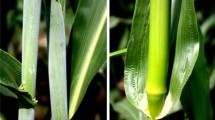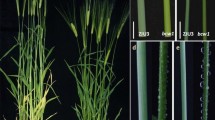Abstract
Sorghum is distinct from other cereal crops due to its ability to produce profuse amount of epicuticular wax (EW or bloom) on its culm and leaves along with less permeable cuticle which are considered to be important traits contributing to abiotic stress tolerance. Here, we report the molecular mapping and characterization of BL OO M-C UTICLE (BLMC), a locus associated with production of profuse wax, using a mutant mapping population developed from a cross between BTx623 (wild type with profuse wax) and KFS2021 (a mutant with greatly reduced wax). The F2 progenies were genotyped using known and newly developed microsattelite markers to establish a molecular map of BLMC. The locus mapped to a 3.6-centimorgans (cM) interval in the terminal end of sorghum chromosome 10 with flanking markers Xsbarslbk10.47 and Xcup42. Targeted mapping delimited BLMC to as small as 0.7 cM region and facilitated identification of three cosegregating markers with the trait. The BLMC region corresponds to approximately 153,000 bp and candidate genes identified include among others an acyl CoA oxidase (a gene involved in lipid and wax biosynthesis) and seven other putative transcripts. Phenotypic characterization showed that in addition to disrupting the EW production, BLMC mutation reduced culm and leaf cuticle, increased plant death rating in the field at anthesis and significantly reduced the C:28 to C:30 free fatty acid fractions of culm and leaf EW. These results clearly support the important role of BLMC in the expression of profuse wax and enhanced cuticular features of sorghum. Genetic mapping of BLMC opened avenues for identification of genes involved in the cuticle/wax pathway of sorghum and their application for improvement of abiotic stress tolerance.



Similar content being viewed by others
References
Aharoni A, Dixit S, Jetter R, Thoenes E, van Arkel G, Pereira A (2004) The SHINE clade of AP2 domain transcription factors activates wax biosynthesis, alters cuticle properties, and confers drought tolerance when overexpressed in Arabidopsis. Plant Cell 16:2463–2480
Beattie G, Marcel L (2002) Effect of alterations in cuticular wax biosynthesis on the physicochemical properties and topography of maize leaf surfaces. Plant Cell Environ 25:1–16
Blum A (1975) Effect of the Bm gene on epicuticular wax and water relations of Sorghum bicolor L. (Moench). Israel J Bot 24:50–51
Bowers JE, Abbey C, Anderson S, Chang C, Draye X, Hoppe A, Jessup R, Lemke C, Lennington J, Li Z, Lin YR, Liu S, Luo L, Marler B, Ming R, Mitchell S, Qiang D, Reischmann K, Schulze S, Skinner N, Wang Y, Kresovich S, Schertz KF, Paterson AH (2003) A high density genetic recombination map of sequence-tagged sites for Sorghum, as a framework for comparative structural and evolutionary genomics of tropical grains and grasses. Genetics 165:367–386
Burow GB, Franks CD, Xin Z (2008) Genetic and physiological analysis of an irradiated bloomless mutant (epicuticular wax mutant) of sorghum. Crop Sci 48:41–48
Broun P, Pointdexter P, Osborne E, Jiang C, Reichman JL (2004) WIN1, a transcriptional activator of epidermal wax accumulation in Arabidopsis. Proc Natl Acad Sci USA 101:4706–4711
Chen X, Goodwin M, Boroff V, Liu X, Jenks M (2003) Cloning and characterization of the WAX2 gene of Arabidopsis involved in cuticle membrane and wax production. Plant Cell 15:1170–1185
Chittenden LM, Schertz KF, Lin YR, Wing RA, Paterson AH (1994) A detailed RFLP map of Sorghum bicolor x S. propinquum, suitable for high density mapping suggests ancestral duplication of Sorghum chromosomes or chromosomal segments. Theor Appl Genet 87:925–933
Ebercon A, Blum A, Jordan W (1977) A rapid colorimetric method for epicuticular wax content of Sorghum leaves. Crop Sci 17:179–180
Goodwin SM, Jenks MA (2005) Plant cuticle function as a barrier to water loss. In: Jenks MA, Hasegawa PM (eds) Plant abiotic stress. Blackwell, Oxford
Hansen JD, Pyee J, Xia Y, Wen T-J, Robertson DS, Kolattukudy PE, Nikolau BJ, Schnable PS (1997) The glossy1 locus of maize and an epidermis-specific cDNA from Kleinia odora define a class of receptor-like proteins required for the normal accumulation of cuticular waxes. Plant Phys 113:1091–1100
Jenks MA, Joly R, Peters P, Rich P, Axtell JD, Ashworth EN (1994) Chemically induced cuticle mutation affecting epidermal conductance to water vapor and disease susceptibility in Sorghum bicolor (L.) Moench. Plant Phys 105:1239–1245
Jenks MA, Eigenbrode SD, Tuttle HA, Feldmann K (1995) Leaf epicuticular waxes on the eceriferum mutants of Arabidopsis. Plant Phys 108:369–377
Jenks MA, Rashotte AM, Tuttle HA, Feldmann KA (1996) Mutants in Arabidopsis thaliana altered in epicuticular wax and leaf morphology. Plant Phys 110:377–385
Jenks MA, Rich PJ, Rhodes D, Ashworth EN, Axtell JD, Ding CK (2000) Leaf culm cuticular waxes on bloomless and sparse-bloom mutants of Sorghum bicolor. Phytochemistry 54:577–584
Jordan W, Monk R, Miller F, Rosenow D, Clark L, Shouse P (1983) Environmental physiology of sorghum. I. Environmental and genetic control of epicuticular wax load. Crop Sci 23:552–558
Jordan W, Shouse P, Blum A, Miller F, Monk R (1984) Environmental physiology of sorghum. II. Epicuticular wax load and cuticular transpiration. Crop Sci 24:1168–1173
Karper R (1933) Inheritance of waxy endosperm in sorghum. J Hered 24:257–262
Kim JS, Klein PE, Klein RR, Price HJ, Mullet JE, Stelly DM (2005) Chromosome identification and nomenclature of Sorghum bicolor. Genetics 169:1169–1173
Kong L, Dong J, Hart GE (2000) Characteristics, linkage map positions, and allelic differentiation of Sorghum bicolor (L.) Moench DNA simple-sequence repeats (SSRs). Theor Appl Genet 101:438–448
Koorneef M, Hanhart C, Thiel F (1989) A genetic and phenotypic description of eceriferum (cer) mutants in Arabidopsis thaliana. J Hered 80:118–122
Kosambi D (1944) The estimation of map distance from recombination values. Ann Eugen 12:172–175
Lander E, Green P, Abrahamson J, Barlow A, Daly M, Stein L, Newburg L (1987) MAPMAKER: an interactive computer package for constructing primary genetic linkage maps of experimental and natural populations. Genomics 1:174–181
Lolle S, Berlyn G, Engstrom E, Krolikowski K, Reiter W, Pruitt R (1997) Developmental regulation of cell interactions in the Arabidopsis fiddlehead-1 mutant; a role for the epidermal cell wall and cuticle. Dev Biol 189:311–321
Menz MA, Klein RR, Mullet JE, Obert JA, Unruh NC, Klein PE (2002) A high-density genetic map of Sorghum bicolor (L.) Moench based on 2926 AFLP, RFLP and SSR markers. Plant Mol Biol 48:483–499
Millar AA, Clemens S, Zachgo S, Giblin M, Taylor D, Kunst L (1999) CUT1, an Arabidopsis gene required for cuitcular wax biosynthesis and pollen fertility, encodes a very-long-chain fatty acid condensing enzyme. Plant Cell 11:825–838
Nawrath C (2006) Unraveling the complex network of cuticular structure and function. Curr Opin Plant Biol 9:281–287
O’Toole JC, Cruz RT (1983) Genotypic variation in epicuticular wax of rice. Crop Sci 23:392–394
Rooney WL (2000) Genetics and cytogenetics of sorghum. In: Smith CW, Frederiksen RA (eds) Sorghum: origin, history, technology and production. Wiley, NY, pp 261–305
Rooney WL (2004) Sorghum improvement-integrating traditional and new technology to produce improved genotypes. Adv Agron 83:37–109
Schloss SJ, Mitchell SE, White GM, Kukatla R, Bowers JE, Paterson AH, Kresovich S (2002) Characterization of RFLP probe sequences for gene discovery and SSR development in Sorghum bicolor (L.) Moench. Theor Appl Genet 105:912–920
Sturaro M, Hartings H, Schmelzer E, Velasco R, Salamini F, Motto M (2005) Cloning and characterization of a maize gene involved in cuticle membrane and wax production. Plant Physiol 138:478–489
Shepherd T, Griffiths DW (2006) The effects of stress on plant cuticular waxes. New Phytol 171:469–499
Temnykh S, DeClerk G, Lukashova A, Lipovich L, Cartinhour S, McCouch S (2001) Computational and experimental analysis of microsatellites in rice (Oryza sativa L.) frequency, length variation, transposon associations, and genetic marker potential. Genome Res 11:1441–1452
Voorrips RE (2002) MapChart: software for the graphical presentation of linkage maps and QTLs. J Hered 93:77–78
Wu YQ, Huang Y (2006) An SSR genetic map of Sorghum bicolor (L.) Moench and its comparison to a published genetic map. Genome 50:84–89
Xu X, Dietrich CR, Delledone M, Xia Y, Wen T-J, Robertson D, Nikolau B, Schnable P (1997) Sequence analysis of the cloned glossy8 gene of maize suggests that it may code for a Β-ketoacyl reductase required for the biosynthesis of cuticular waxes. Plant Physiol 115:501–510
Xu X, Dietrich CR, Lessire R, Nikolau B, Schnable P (2002) The endoplasmic reticulum-associated maize GL8 protein is a component of the acyl-coenzyme A elongase involved in the production of cuticular waxes. Plant Physiol 128:924–926
Zhang JY, Broeckling CD, Blancaflor EB, Sledge MK, Summer LW, Wang ZW (2005) Overexpression of WXP1, a putative Medicago trancatula AP2 domain-containing transcription factor gene, increases cuticular wax accumulation and enhances drought tolerance in transgenic alfalfa (Medicago sativa). Plant J 42:689–707
Acknowledgments
The authors would like to thank Dr. Matthew Jenks for helpful discussion and the technical assistance of Halee Hughes, Charles Woodfin, Naomi Kaskela and Lance Layton.
Author information
Authors and Affiliations
Corresponding author
Additional information
Communicated by H. T. Nguyen.
Rights and permissions
About this article
Cite this article
Burow, G.B., Franks, C.D., Acosta-Martinez, V. et al. Molecular mapping and characterization of BLMC, a locus for profuse wax (bloom) and enhanced cuticular features of Sorghum (Sorghum bicolor (L.) Moench.). Theor Appl Genet 118, 423–431 (2009). https://doi.org/10.1007/s00122-008-0908-y
Received:
Accepted:
Published:
Issue Date:
DOI: https://doi.org/10.1007/s00122-008-0908-y




